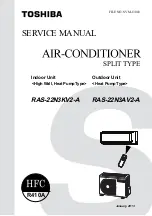
1. SAFETY PRECAUTIONS
Installing, staring up, and servicing air-conditioning equipment can be hazardous due to system pressures, electrical
components, and equipment location (roofs, elevated structures, etc.).
Only trained, qualified installers and service mechanics should install, start-up, and service this equipment.
Untrained personnel can perform basic maintenance functions such as cleaning coils. All other operations should be
performed by trained service personnel.
When working on the equipment, observe precautions in the literature and on tags, stickers, and labels attached to the
equipment.
Follow all safety codes, Wear safety glasses and work gloves. Keep quenching cloth and fire extinguisher near by
when brazing. Use care in handling, rigging, and setting bulky equipment.
Read these instructions thoroughly and follow all warnings or cautions included in literature and attached to the unit.
Consult local building codes and National Electrical Code (NEC) for special requirements. Recognize safety information.
This is the safety-alert symbol
!
. When you see this symbol on the unit and in instructions or manuals, be alert to the
potential for personal injury. Understand these signal words : DANGER, WARNING, and CAUTION. These words are
used with the safety-alert symbol.
DANGER identifies the most serious hazards which will result in severs personal injury or death. WARNING signifies
hazards which could result in personal injury or death. CAUTION is used to identify unsafe practices which may result
in minor personal injury or product and property damage. NOTE is used to highlight suggestions which will result in
enhanced installation, reliability, or operation.
•
Before installation, please read these precautions for safety carefully.
•
Be sure to follow the precautions provided here to avoid safety risks. The symbols and their meanings are shown below.
WARNING
: It indicates that incorrect use of this unit may cause severe injury or death.
CAUTION
: FAILURE TO FOLLOW THIS CAUTION may result in equipment damage or improper operation and
personal injury.
CAUTION
New refrigerant air conditioner installation
•
THIS AIR CONDITIONER USES THE NEW HFC REFRIGERANT (R410A), WHICH DOES NOT DESTROY THE
OZONE LAYER.
R410A refrigerant is affected by inpurities such as water and oils because the pressure of R410A refrigerant is approx.
1.6 times of refrigerant R22.
ALSO NEW OILS ARE USED WITH R410A, THUS ALWAYS USE NEW REFRIGERANT PIPING AND DO NOT
ALLOW MOISTURE OR DUST TO ENTER THE SYSTEM.
To avoid mixing refrigerant and refrigerant machine oil, the sizes of charging port on the main unit is different than
those used on R22 machines and different tools will be required.
•
EQUIPMENT DAMAGE HAZARD
Failure to follow this caution may result in equipment damage or improper operation.
Do not bury more than 36 in. (914 mm) of refrigerant pipe in the ground. If any section of pipe is buried, there must
be a 6 in. (152 mm) vertical rise to the valve connections on the outdoor units. If more than the recommended length
is buried, refrigerant may migrate to the cooter buried section during extended periods of system shutdown. This
causes refrigerant slugging and could possibly damage the compressor at start-up.
FILE NO. SVM-13003
−
2
−
Summary of Contents for RAS-22N3AV2-A
Page 109: ...TOSHIBA CARRIER THAILAND CO LTD ...




































